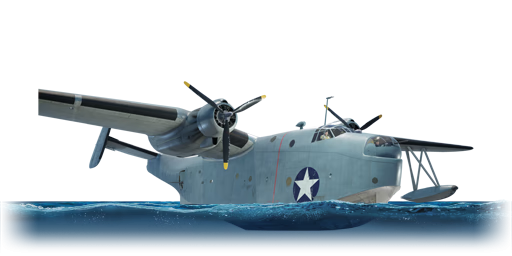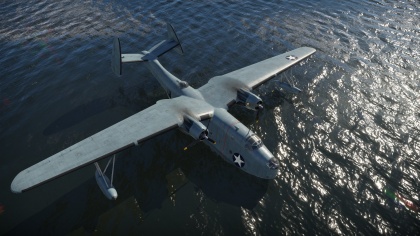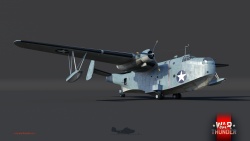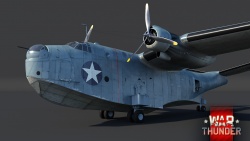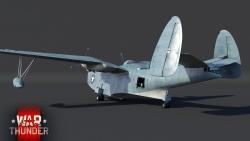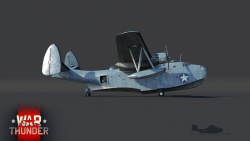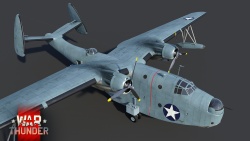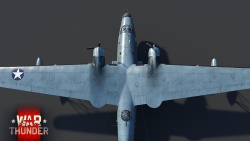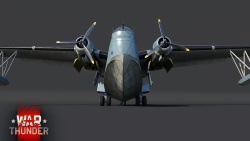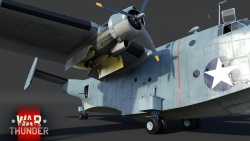Difference between revisions of "PBM-3 "Mariner""
(→Description: Edits) |
(→Modules) (Tag: Visual edit) |
||
| Line 196: | Line 196: | ||
| Airframe | | Airframe | ||
| | | | ||
| − | | | + | |Mk 12 Mod 0 |
|- | |- | ||
| III | | III | ||
| Line 203: | Line 203: | ||
| | | | ||
| New 12 mm MGs (turret) | | New 12 mm MGs (turret) | ||
| − | | | + | |MBC-25 |
|- | |- | ||
| IV | | IV | ||
| Line 247: | Line 247: | ||
== Media == | == Media == | ||
<!-- ''Excellent additions to the article would be video guides, screenshots from the game, and photos.'' --> | <!-- ''Excellent additions to the article would be video guides, screenshots from the game, and photos.'' --> | ||
| + | |||
;Images | ;Images | ||
<div><ul> | <div><ul> | ||
Revision as of 12:50, 3 September 2020
Contents
Description
The PBM-3 "Mariner" is a premium gift rank II American bomber
with a battle rating of 3.0 (AB/RB/SB). It was introduced during Update 1.85 "Supersonic" as part of the Sea Voyage event that ran from 21 February to 11 March 2019.
General info
Flight Performance
Due to the fact that it is a large seaplane, the PBM-3 is not very manoeuvrable and has trouble banking. However, when you get into a high-angle bank, it does turn fairly easily because of its large wings. As for payloads, it doesn't matter which payload you take for flight performance. All of the bombs are contained in the nacelle-mounted bomb bays and won't have a large difference in manoeuvrability.
| Characteristics | |||||||
|---|---|---|---|---|---|---|---|
| Stock | |||||||
| Max Speed (km/h at 3,962 m) |
Max altitude (meters) |
Turn time (seconds) |
Rate of climb (meters/second) |
Take-off run (meters) | |||
| AB | RB | AB | RB | AB | RB | ||
| 336 | 325 | 6200 | 34.4 | 35.3 | 3.5 | 3.5 | 585 |
| Upgraded | |||||||
| Max Speed (km/h at 3,962 m) |
Max altitude (meters) | Turn time (seconds) | Rate of climb (meters/second) |
Take-off run (meters) | |||
| AB | RB | AB | RB | AB | RB | ||
| 364 | 349 | 6200 | 33.8 | 34.0 | 6.5 | 4.9 | 585 |
Details
| Features | ||||
|---|---|---|---|---|
| Combat flap | Take-off flap | Landing flap | Air brakes | Arrestor gear |
| ✓ | ✓ | ✓ | X | X |
| Limits | ||||
|---|---|---|---|---|
| Wing-break speed (km/h) |
Gear limit (km/h) |
Combat flap (km/h) |
Max Static G | |
| + | - | |||
| 405 | 450 | 340 | ~?? | ~? |
| Optimal velocities | |||
|---|---|---|---|
| Ailerons (km/h) |
Rudder (km/h) |
Elevators (km/h) |
Radiator (km/h) |
| < 220 | < 220 | < 230 | > 312 |
| Compressor (RB/SB) | ||
|---|---|---|
| Setting 1 | ||
| Optimal altitude | 100% Engine power | WEP Engine power |
| 2,042 m | 1,500 hp | 1,575 hp |
| Setting 2 | ||
| Optimal altitude | 100% Engine power | WEP Engine power |
| 4,542 m | 1,350 hp | 1,418 hp |
Survivability and armour
- No armour
- Small fuel tanks in wing roots, rest in bottom of fuselage
Armaments
Suspended armament
The PBM-3 "Mariner" is able to be equipped with:
- 12 x 100 lb AN-M30A1 bombs
- 8 x 500 lb AN-M64A1 bombs
- 8 x 1000 lb AN-M65A1 bombs
Defensive armament
The PBM-3 "Mariner" is defended with:
- 1 x 12.7 mm M2 Browning machine gun, nose turret (400 rpg)
- 1 x 12.7 mm M2 Browning machine gun, 2 x waist turret (375 rpg = 750 total)
- 1 x 12.7 mm M2 Browning machine gun, dorsal turret (600 rpg)
- 1 x 12.7 mm M2 Browning machine gun, tail turret (350 rpg)
Usage in battles
In RB, the PBM-3 should be used as a traditional heavy bomber. Thanks to your large bombload, you will be readily able to destroy two bases, no matter what the maximum battle rating in the game is. In an uptier, it will take 4x 1000lbs to destroy a base and in a downtier, it will take 3x 1000lbs. Try and stay away from enemy fighters whenever possible, as your defensive turrets will have trouble against many aircraft that you face.
Manual Engine Control
| MEC elements | ||||||
|---|---|---|---|---|---|---|
| Mixer | Pitch | Radiator | Supercharger | Turbocharger | ||
| Oil | Water | Type | ||||
| Not controllable | Controllable Has automatic pitch |
Controllable | Controllable | Separate | Controllable | Not controllable |
Modules
| Tier | Flight performance | Survivability | Weaponry | ||
|---|---|---|---|---|---|
| I | Fuselage repair | Radiator | Turret 12 mm | ||
| II | Compressor | Airframe | Mk 12 Mod 0 | ||
| III | Wings repair | Engine | New 12 mm MGs (turret) | MBC-25 | |
| IV | Engine injection | Cover | LBC-25 | ||
| This is a premium vehicle: all modifications are unlocked on purchase | |||||
Pros and cons
Pros:
- Massive bomb load
Cons:
- Big, slow target
- Lackluster defensive turrets
- Does not have controllable landing gear
History
In the mid 1930s, the U.S. Navy was eager to replace their outdated flying boats with newer models. In order to do so, the Navy started a competition between aircraft manufacturers, whose winner would receive a production contract with the Navy.
The Martin company submitted the designs on their four-engine Model 160 aircraft, which didn’t garner any significant interest from the Navy. However, Martin continued to work on the design, reworking it into a two-engine aircraft, designated Model 162.
This design proved to be a lot more successful, with the Navy quickly ordering for a prototype of the aircraft to be produced. Designated XPBM-1 “Mariner”, the prototype conducted its maiden flight in February 1939. Following successful trials, the aircraft was adopted by the USN as early as September 1939 and ordered into production.
In late 1940, Martin received a large order for more flying boats to be manufactured. However, with the company’s production capacity being reached, construction of these new machines was delayed. In the meantime, the PBM was further improved by installing new engines, increasing overall size and doubling payload capacity. The new PBM-3 Mariner entered production in 1941, with the first batch of 32 vehicles entering service in 1942.
The Mariners primarily served with the USN as coastal patrol aircraft before the outbreak of WW2. However, after the United States’ entry into WW2, Mariners were used in the anti-submarine role in the Atlantic and also took part in operations in the Pacific Theatre.
The PBM-3 Mariner flying boats of the third series served very briefly during WW2, as nearly all PBM-3s from the first series were converted into unarmed transport machines shortly after their construction. Nevertheless, the aircraft proved to be very successful and further models were built in large numbers - in total more than 1360 Mariner vehicles of different modifications. Mariners were also used in small numbers by Great Britain, Australia, Argentina, Uruguay and the Netherlands. The last Mariners were phased out of service during the 1960s, being replaced by newer aircraft.
- From Devblog
Media
- Images
- Videos
See also
Links to the articles on the War Thunder Wiki that you think will be useful for the reader, for example:
- reference to the series of the aircraft;
- links to approximate analogues of other nations and research trees.
External links
| Glenn L. Martin Company | |
|---|---|
| Attackers | AM-1 |
| Bombers | B-10B · B-26B · PBM-1 · PBM-3 · PBM-5A |
| Jet bombers | B-57A* · B-57B* |
| Export | Martin 139WC · Martin 167-A3 · B-26C |
| * These aircraft were license-built from The English Electric Company Limited who developed and built the British English Electric Canberra. | |
| USA bombers | |
|---|---|
| Dive | SB2U-2 · SB2U-3 · SBD-3 · SB2C-1C · SB2C-4 |
| Torpedo | TBD-1 · PBY-5 Catalina · PBY-5A Catalina · TBF-1C · BTD-1 |
| Medium | B-10B · B-18A · B-34 · PV-2D · B-25J-1 · B-25J-20 · A-26C-45 · A-26C-45DT · B-26B |
| Heavy | B-17E · B-17E/L · B-17G-60-VE · PB4Y-2 · B-24D-25-CO · B-29A-BN |
| Hydroplanes | OS2U-1 · OS2U-3 · PBM-1 "Mariner" · PBM-3 "Mariner" · PBM-5A "Mariner" |
| USA premium aircraft | |
|---|---|
| Fighters | Thach's F2A-1 · Galer's F3F-2 · F2G-1 · F4U-4B VMF-214 · P-26A-34 · Rasmussen's P-36A · P-40C · P-43A-1 |
| P-47M-1-RE · ⋠P-47M-1-RE · P-51A · P-51D-10 · P-51D-20-NA · ␠Kingcobra · XP-55 | |
| ▃A6M2 · ▃Ki-43-II · ▃Ki-61-Ib · ▃Bf 109 F-4 · ▃Fw 190 A-8 · ▃Spitfire LF Mk IXc | |
| Twin-engine fighters | XP-38G · Bong's P-38J-15 · P-38K · YP-38 · P-61A-11 · XF5F · XP-50 · F7F-3 |
| Jet fighters | P-59A · F-86F-35 · F-89B · F-89D · F-4S Phantom II · F-5C · F-20A |
| Strike aircraft | A-1H · A2D-1 · AU-1 · XA-38 · AV-8A · AV-8B (NA) · A-6E TRAM · A-10A |
| Bombers | A-26C-45DT · B-10B · BTD-1 · PBM-3 "Mariner" · PBM-5A "Mariner" · PV-2D |


